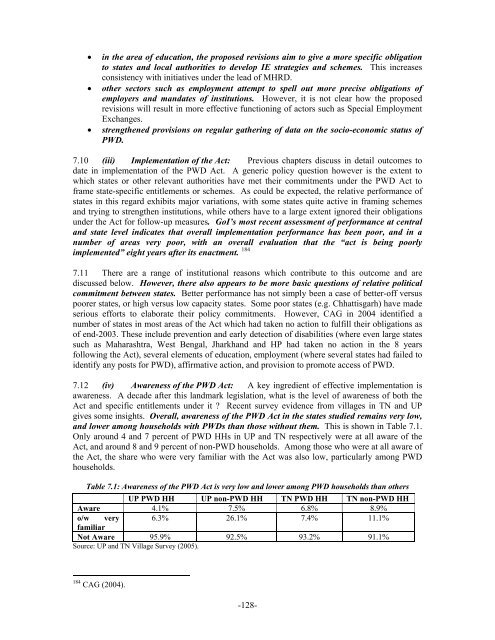People with Disabilities in India: From Commitment to Outcomes
People with Disabilities in India: From Commitment to Outcomes
People with Disabilities in India: From Commitment to Outcomes
Create successful ePaper yourself
Turn your PDF publications into a flip-book with our unique Google optimized e-Paper software.
• <strong>in</strong> the area of education, the proposed revisions aim <strong>to</strong> give a more specific obligation<br />
<strong>to</strong> states and local authorities <strong>to</strong> develop IE strategies and schemes. This <strong>in</strong>creases<br />
consistency <strong>with</strong> <strong>in</strong>itiatives under the lead of MHRD.<br />
• other sec<strong>to</strong>rs such as employment attempt <strong>to</strong> spell out more precise obligations of<br />
employers and mandates of <strong>in</strong>stitutions. However, it is not clear how the proposed<br />
revisions will result <strong>in</strong> more effective function<strong>in</strong>g of ac<strong>to</strong>rs such as Special Employment<br />
Exchanges.<br />
• strengthened provisions on regular gather<strong>in</strong>g of data on the socio-economic status of<br />
PWD.<br />
7.10 (iii) Implementation of the Act: Previous chapters discuss <strong>in</strong> detail outcomes <strong>to</strong><br />
date <strong>in</strong> implementation of the PWD Act. A generic policy question however is the extent <strong>to</strong><br />
which states or other relevant authorities have met their commitments under the PWD Act <strong>to</strong><br />
frame state-specific entitlements or schemes. As could be expected, the relative performance of<br />
states <strong>in</strong> this regard exhibits major variations, <strong>with</strong> some states quite active <strong>in</strong> fram<strong>in</strong>g schemes<br />
and try<strong>in</strong>g <strong>to</strong> strengthen <strong>in</strong>stitutions, while others have <strong>to</strong> a large extent ignored their obligations<br />
under the Act for follow-up measures. GoI’s most recent assessment of performance at central<br />
and state level <strong>in</strong>dicates that overall implementation performance has been poor, and <strong>in</strong> a<br />
number of areas very poor, <strong>with</strong> an overall evaluation that the “act is be<strong>in</strong>g poorly<br />
implemented” eight years after its enactment. 184<br />
7.11 There are a range of <strong>in</strong>stitutional reasons which contribute <strong>to</strong> this outcome and are<br />
discussed below. However, there also appears <strong>to</strong> be more basic questions of relative political<br />
commitment between states. Better performance has not simply been a case of better-off versus<br />
poorer states, or high versus low capacity states. Some poor states (e.g. Chhattisgarh) have made<br />
serious efforts <strong>to</strong> elaborate their policy commitments. However, CAG <strong>in</strong> 2004 identified a<br />
number of states <strong>in</strong> most areas of the Act which had taken no action <strong>to</strong> fulfill their obligations as<br />
of end-2003. These <strong>in</strong>clude prevention and early detection of disabilities (where even large states<br />
such as Maharashtra, West Bengal, Jharkhand and HP had taken no action <strong>in</strong> the 8 years<br />
follow<strong>in</strong>g the Act), several elements of education, employment (where several states had failed <strong>to</strong><br />
identify any posts for PWD), affirmative action, and provision <strong>to</strong> promote access of PWD.<br />
7.12 (iv) Awareness of the PWD Act: A key <strong>in</strong>gredient of effective implementation is<br />
awareness. A decade after this landmark legislation, what is the level of awareness of both the<br />
Act and specific entitlements under it ? Recent survey evidence from villages <strong>in</strong> TN and UP<br />
gives some <strong>in</strong>sights. Overall, awareness of the PWD Act <strong>in</strong> the states studied rema<strong>in</strong>s very low,<br />
and lower among households <strong>with</strong> PWDs than those <strong>with</strong>out them. This is shown <strong>in</strong> Table 7.1.<br />
Only around 4 and 7 percent of PWD HHs <strong>in</strong> UP and TN respectively were at all aware of the<br />
Act, and around 8 and 9 percent of non-PWD households. Among those who were at all aware of<br />
the Act, the share who were very familiar <strong>with</strong> the Act was also low, particularly among PWD<br />
households.<br />
Table 7.1: Awareness of the PWD Act is very low and lower among PWD households than others<br />
UP PWD HH UP non-PWD HH TN PWD HH TN non-PWD HH<br />
Aware 4.1% 7.5% 6.8% 8.9%<br />
o/w very 6.3% 26.1% 7.4% 11.1%<br />
familiar<br />
Not Aware 95.9% 92.5% 93.2% 91.1%<br />
Source: UP and TN Village Survey (2005).<br />
184 CAG (2004).<br />
-128-










